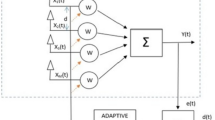Abstract
In this paper we consider user scheduling, ordering and transmit covariance matrix optimization problems under successive zero-forcing (SZF) precoding for multiuser multiple-input multiple-output downlink. We propose a heuristic user scheduling metric and an intermediate user grouping technique to develop a low complexity greedy scheduling algorithm. A suboptimal user ordering technique is also proposed for transmit covariance matrix optimization under SZF. Proposed algorithm is of low complexity, but performs closely to the highly complex exhaustive search algorithm. For transmit covariance optimization under SZF, a dirty paper coding based algorithm has been previously proposed, which is computationally very complex. In this paper, we propose a suboptimal but much simplified algorithm, which employs an iterative procedure similar to a known multiple access channel (MAC) covariance optimization algorithm, but does not involve multiple levels of covariance matrix transformations. With the proposed suboptimal user ordering the exhaustive search through all possible user orders is avoided during transmit covariance matrix optimization resulting in a significant complexity reduction, and without a significant performance penalty. Simulation results show that the proposed algorithm performs very close to the known algorithm in the low SNR region.






Similar content being viewed by others
Notes
Part of this work was presented in [14]. This paper expands on that work providing a substantial revision to the proposed algorithm description and results.
We note here that the optimization of the numbers of transmitted streams to the users will result in improved sum rate. However, the algorithm to achieve that will be more complex. Analysis of performance and complexity of such technique is an interesting problem for future work. However, it is beyond the scope of this paper. On the other hand, different numbers of receive antennas for different users can also be considered with the proposed algorithm (again assuming the number of transmitted streams equal to the number of receive antennas).
Note that generally user scheduling algorithm is used to select the users to be served in a given time slot, and then optimization of the transmit covariance matrices for the selected users is performed. Therefore, in that case the user order will not have to be re-computed as in [15], since the proposed user selection algorithm would have already determined the user order as explained in Section 3.
References
Dabbagh, A. D., & Love, D. J. (2007). Precoding for multiple antenna Gaussian broadcast channels with successive zero-forcing. IEEE Transactions on Signal Processing, 55(7), 3837–3850.
Jindal, N., Rhee, W., Vishwanath, S., Jafar, S. A., & Goldsmith, A. (2005). Sum power iterative water-filling for multi-antenna Gaussian broadcast channels. IEEE Transactions on Information Theory, 51(4), 1570–1580.
Costa, M. H. M. (1983). Writing on dirty paper. IEEE Transactions on Information Theory, 29(3), 439–441.
Caire, G., & Shamai, S. (2000). On achievable rates in a multi-antenna broadcast downlink. In Proceedings of the 38th Annual Allerton Conference on Communication, Control and Computing, Monticello, IL.
Caire, G., & Shamai, S. (2003). On the achievable throughput of a multiantenna Gaussian broadcast channel. IEEE Transactions on Information Theory, 49(7), 1691–1706.
Vishwanath, S., Jindal, N., & Goldsmith, A. (2003). Duality, achievable rates, and sum-rate capacity of Gaussian MIMO broadcast channels. IEEE Transactions on Information Theory, 49(10), 2658–2668.
Tu, Z., & Blum, R. S. (2003). Multiuser diversity for a dirty paper approach. IEEE Communications Letters, 7(8), 370–372.
Yoo, T., & Goldsmith, A. (2006). On the optimality of multiantenna broadcast scheduling using zero-forcing beamforming. IEEE Journal on Selected Areas in Communications, 24(3), 528–541.
Spencer, Q. H., Swindlehurst, A. L., & Haardt, M. (2004). Zero forcing methods for downlink spatial multiplexing in multiuser MIMO channels. IEEE Transactions on Signal Processing, 52(2), 461–471.
Tejera, P., Utschick, W., Bauch, G., & Nossek, J. A. (2006). Subchannel allocation in multiuser multiple-input multiple-output systems. IEEE Transactions on Information Theory, 52(10), 4721–4733.
Sigdel, S., & Krzymień, W. A. (2009). Simplified fair scheduling and antenna selection algorithms for multiuser MIMO orthogonal space-division multiplexing downlink. IEEE Transactions on Vehicular Technology, 58(3), 1329–1344.
Shen, Z., Chen, R., Andrews, J. G., Heath, J. R. W., & Evans, B. L. (2006). Low complexity user selection algorithms for multiuser MIMO systems with block diagonalization. IEEE Transactions on Signal Processing, 54(9), 3658–3663.
Kobayashi, M., & Caire, G. (2007). Joint beamforming and scheduling for a multi-antenna downlink with imperfect transmitter channel knowledge. IEEE Journal on Selected Areas in Communications, 25(7), 1468–1477.
Sigdel, S., & Krzymień, W. A. (2009). Efficient user selection and ordering algorithms for successive zero-forcing precoding for multiuser MIMO downlink. In Proceedings of the IEEE VTC’09-Spring (pp. 1–6).
Sigdel, S., & Krzymień, W. (2009). Simplified transmit covariance optimization and user ordering algorithm for successive zero-forcing precoding. In Proceedings of the IEEE SPAWC’09 (pp. 235–239).
Elliott, R. C., & Krzymień, W. A. (2011). Improved and weighted sum rate maximization for successive zero-forcing in multiuser MIMO systems. EURASIP Journal on Wireless Communications and Networking, Special Issue on Recent Advances in Multiuser MIMO Systems, 133, 1–16. doi:10.1186/1687-1499-2011-133.
Yu, W., & Rhee, W. (2006). Degrees of freedom in wireless multiuser spatial multiplex systems with multiple antennas. IEEE Transactions on Communications, 54(10), 1747–1753.
Acknowledgments
Funding for this work has been provided by TRLabs, TELUS, Huawei Technologies, the Rohit Sharma Professorship, MITACS, and the Natural Sciences and Engineering Research Council (NSERC) of Canada.
Author information
Authors and Affiliations
Corresponding author
Additional information
This work was in part presented at and published in the proceedings of the 69th IEEE Vehicular Technology Conference (VTC’09-Spring), Barcelona, Spain, April 2009, and the 10th IEEE International Workshop on Signal Processing Advances in Wireless Communications (SPAWC’09), Perugia, Italy, June 2009.
Rights and permissions
About this article
Cite this article
Sigdel, S., Krzymień, W.A. Low Complexity User Scheduling, Ordering and Transmit Covariance Matrix Optimization Algorithms for Successive Zero-Forcing Precoding. Wireless Pers Commun 75, 2467–2484 (2014). https://doi.org/10.1007/s11277-013-1477-1
Published:
Issue Date:
DOI: https://doi.org/10.1007/s11277-013-1477-1




